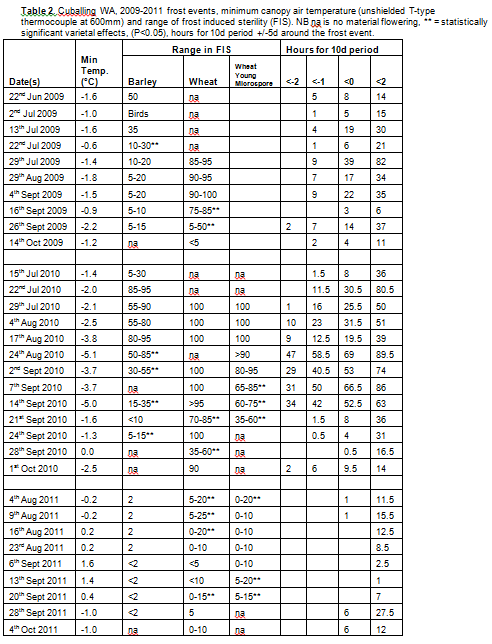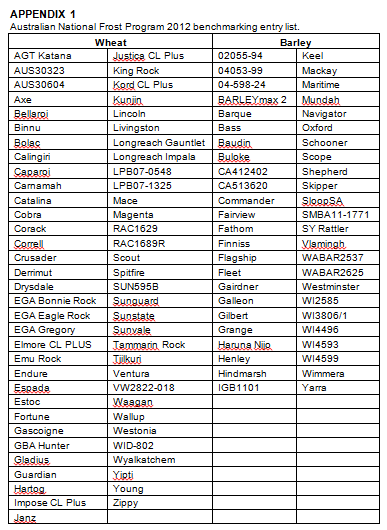Update on Frost Pre-breeding Research
Author: Ben Biddulph, Nathan Height, Tim March, Michael Laws, Paul Eckermann, Jason Reinheimer & Jason Eglinton | Date: 20 Mar 2013
Key Messages
- The Australian National Frost Program (ANFP) was established in 2012 by UA, DAFWA and GRDC. Frost sensitivity ratings are being developed for current wheat and barley varieties to assist growers manage the risk of frost.
- Reductions in grain number start to occur in wheat and barley when canopy temperatures at flowering are around 0 and -2°C respectively with no visible signs of frost damage.
- Canopy temperatures at flowering below -4°C and -6°C in wheat and barley respectively can cause major crop losses. For frost events above these temperatures varietal variation in frost sensitivity has been identified.
Aims
National frost pre-breeding research has three broad aims.
1. Continue to develop approaches to reliably screen for frost tolerance.
2. Develop the capacity to identify and select frost tolerant barley and wheat germplasm for use in breeding programs to reduce frost sensitivity of future commercial varieties.
3. Benchmark frost tolerance in current wheat and barley varieties to develop frost sensitivity ratings that growers can use to manage the risk of frost.
Method
Frost screening nurseries
GRDC research projects over the past decade have developed field-based frost screening protocols with improved accuracy and repeatability. Multiple times of sowing are used at each site to increase the probability that the test lines are at the flowering stage when a natural frost event occurs. On site weather stations monitor the temperature at the crop canopy. Following a frost event, heads within each plot are destructively sampled to determine if they are at the flowering stage. Once identified, a morphological template is set and used to tag a minimum of 30 flowering heads within the plot. The tagged heads are then collected at mid grain fill and assessed for frost induced sterility (FIS) which is expressed as the percentage of sterile florets within each head. Precision in tagging heads at the same developmental stage is important as susceptibility to frost varies across developmental stages. Plant morphological traits are also measured as co-variates to help account for within plot variation. Combined, the developed methods minimise confounding effects due to maturity and enables repeatable results over successive seasons and sites.
Australian National Frost Program (ANFP) - Coordination and phenotyping
The field-based frost screening methods described above now form the basis of the ANFP. Established in 2012, the ANFP consists of three dedicated frost screening nurseries in the Northern (Narrabri, NSW), Southern (Loxton, SA) and Western (Merredin, WA) growing regions. The ANFP has significantly increased the national frost screening capacity to support pre-breeding and breeding projects.
In the first instance the ANFP has been contracted to benchmark frost tolerance in existing and soon to be released barley and wheat varieties. Once robust data is obtained from multiple seasons the output of this will be to provide variety frost ratings to assist growers manage the risk of frost, in a similar way to existing disease ratings.
The first ANFP benchmarking trials were sown in season 2012. In total 48 barley and 65 wheat varieties including durums were evaluated (Appendix 1). All three ANFP sites experienced multiple frost events. In total 76,461 heads were tagged and collected following a frost event and 2,879,650 individual florets assessed for frost induced sterility. The statistical analysis of the 2012 trial data is currently being performed, therefore the results presented below are summarised from previous frost research projects.
Results
Frost tolerance in barley
- Barley has better frost tolerance than wheat.
- Substantial reduction in grain number starts at -2°C (Table 1 and 2) and total crop failure can occur at -6°C in all current varieties.
- Consistent varietal differences in frost sensitivity have been found in WA and SA under mild frosts (0 to -2°C) when damage is in the 10-80% range (Table 1 and 2).
- Long term trials have shown the variety Galleon is significantly more sensitive to frost damage than Keel or Fleet. Available data on the current dominant varieties does not suggest any have specific sensitivities to frost compared to Keel or Fleet.
- Improved tolerance has also been identified in Japanese barley varieties. The tolerance genes from this material have been introduced into Australian adapted backgrounds and validation studies in WA and SA have shown the tolerance level of this material is still comparable to Keel.
Frost tolerance in Wheat
- Wheat is significantly more frost sensitive than barley.
- Substantial reductions in grain number occurs at canopy temperatures below -2°C (Table 1 and 2), however some losses can occur at around 0°C with no signs of a frost event early in the morning. Total crop failure can occur at approximately -4°C in all current varieties.
- Consistent varietal differences in frost sensitivity have been found in WA and SA under mild frosts (0 to -2°C) when sterility is in the 10-80% range (Table 1 and 2).
- From long term trials, Wyalkatchem is more susceptible to frost induced sterility than Young. How this translates into yield loss will be the subject of future research.
- Varietal variation in cold tolerance at booting (Young Microspore ~ Z45) also correlates to frost at flowering both in the field (Table 2.) and under controlled conditions (data not shown).
Genetic analysis of frost tolerance
- To dissect the genetic control of FIS, barley and wheat mapping populations that segregate for frost tolerance have been studied. In barley the Haruna Nijo/Galleon and Amagi Nijo/WI2585 populations were screened with the aim to identify tolerance alleles from the Japanese parents. In wheat the Calingiri/Wyalkatchem population was screened to identify frost susceptible alleles from Wyalkatchem. A second wheat population AUS30323/Correll is currently being screened to identify potential new tolerance alleles from the synthetic derived parent AUS30323 that has shown promising levels of frost tolerance over multiple seasons.
- In barley quantitative trait loci were identified on chromosome 2H and 5H where the Japanese alleles at both these loci were associated with improved frost tolerance (Reinheimer et al. 2004). In wheat a QTL was identified on chromosome 2B where the Wyalkatchem alleles increased frost susceptibility. Comparative analysis of the barley and wheat group 2 chromosome QTL indicates that they are related (March et al. in preparation). This finding suggests that the genetic control of frost tolerance in barley and wheat is similar, thus advances made in either species may benefit both.
- Genetic markers closely linked to the chromosome 2H and 2B frost tolerance QTL in barley and wheat has been identified. Future research will validate the value of these markers to select for improved frost tolerance in breeding programs and also search for improved allelic variation at this locus.

Conclusion
Research over the past 10 years has developed approaches to measure the variation in frost induced sterility with more accuracy and consistency than before. The ANFP has now been established to provide a national frost screening facility to support frost research.
Under severe frost (<-4° for wheat and <-6°C for barley) all varieties tested to date are equally susceptible. However genetic variation has been identified under milder frosts which induce grain sterility in the range of 10-80%. What is not yet well established is if frost induced sterility is directly correlated to yield loss, and if certain varieties are better able to compensate through other mechanisms such as increasing grain size or better filling secondary tillers. Future research will examine variety frost ratings in the context of yield loss under different production conditions.
The ultimate goal remains to deliver a genetic solution for frost tolerance. Future work will continue refining screening methods and search for new sources of tolerance from international germplasm collections that can be incorporated into Australian varieties.
Acknowledgements
Funding for this research is through GRDC and involves collaboration with the University of Adelaide in SA, DEEDI/QUAFFI in QLD, CSIRO PI ACT and the Department of Agriculture and Food WA. The authors also wish to acknowledge the excellent trial site and access to water provided by the Wittwer family, East Cuballing through the Facey Group (2008-2011), the Merredin Dryland Research Institute (2012) for the WA trial sites and SARDI for the Loxton SA trial site.
GRDC Project No.: DAW00162, CSP00143, UA00114, UA00063 and UA00100
Paper reviewed by: Dr Tim March, University of Adelaide, Dr Michael Robertson CSIRO Floreat

GRDC Project Code: DAW00162, CSP00143, UA00114, UA00063 and UA00100,
Was this page helpful?
YOUR FEEDBACK

